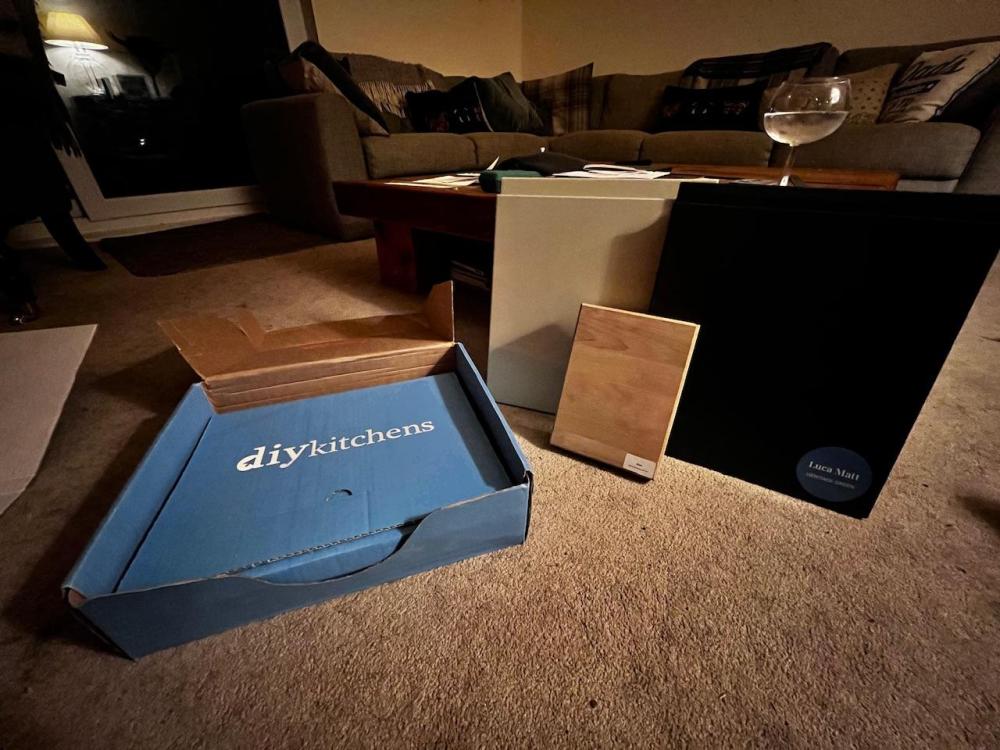Leaderboard
Popular Content
Showing content with the highest reputation on 10/25/23 in all areas
-
Don’t scrimp on stuff like insulation as you can’t upgrade it very easily after you’ve built the house.2 points
-
You can't pump surface water in to a drain unless you know where it's going and you have consent to do so. I think looking at your topography, high water table and soil, you'll have to learn to live with it. You've created a large, flat area with minimal vegetation, a bit of creative landscaping will do wonders.2 points
-
Agreed. Make sure your application for a certificate of lawfulness (and I wouldn't build the garage without one) makes it absolutely clear where the principal elevation is and hence the garage is in the "back" garden. Add all the info you have and go for it. Good luck.2 points
-
Sarking is the best and the preferred option as specified by the Federation of Traditional Metal Roofing Contractors. For several reasons including better pull out resistance for the fixings. Plywood is acceptable and tends to be 'preferred' by the installers as it's cheaper and quicker to install and is certainly an acceptable solution. With some it's even okay to use osb.... so in order of best to worst: 1. sarking 2.plywood 3. osb (but don't use osb if you need high pull out resistance for screws or alternatively you need to reduce fixing spacing around both the perimeter and rest of roof area - this needs to be calculated).2 points
-
I bought a 2.5t Takeuchi TB025 for my project, I've had it 4 years now. It is very old and tatty but starts every time and is still a strong machine. Old used machines are risky, if something major goes wrong with the hydraulics, like the pump or a track motor, then it can be a bill of 0,000s to fix. Fortunately, I've only had a replace a few pins and bushes, had it serviced, replaced the coolant and changed a few track adjuster seals. I am running out things to do with it and my wife is enthusiastic about me finally selling it on now (me less so!). Postives for your own machine are using it whenever you want, with hired in you need to have a job to do with it and get on with it and get the machine off hire promptly so it can put you under pressure, particularly if you are oding DIY. If using your own machine means you can break up jobs over days or weeks, no pressure. Other trades will find it handy having a machine on site, mine can lift bulk bags and living on a big plot that has saved a lot of labour. We've done all sorts with it, lifting steels, lifting large windows onto scaffold, demolising old outbuildings. I've also done a lot of ground clearance of bramble scrub in overgrown areas with it (the grading bucket can skim undergrowth off the surface once you get the knack). I wouldn't fancy a backhoe for house ground works, a digger can get in and out of tight spaces, is very easy to adjust position, it can cross over dug footing trenches, can straddle trenches as you dig them, and is generally very versatile, I reckon a backhoe is a farm machine really, better than noting but a bit of a compromise on house build site, I'd get a digger every time. I think most people who have bought their own machines have found them well worth the investment.2 points
-
In the lab yes, that is how they know it works at very high temperatures. From a quick read though of the article, it seems they are pretending that excess solar energy has zero value and thermal energy has a very high value. I would think that with a bit of digging you will find they are looking to raise funding, not actually sell a product that is useful. Do you remember the man that made a battery from aluminium cans a while back, I bet he has retired on the development money. Then there were all those micro wind and water turbines that would save us. Oh, don't forget the perovskite, that was all the rage 5 years ago. Meanwhile, back in the real world the big boys have raised PV efficiency a few percent and reduced the cost another 5 fold.2 points
-
1 point
-
I find this app a godsend, manual input but daily, weekly, monthly, annual analysis with export facility of data. I use for elec import, export, gas, water. i just I put meter figures off meter or in house display and now have 7 years of data, showing trends vis last year etc. I guess available on android too. https://apps.apple.com/gb/app/meter-readings/id3205513091 point
-
1 point
-
I would not contact your supplier yet. I would spend say a week gathering evidence. Daily meter reading on the display on the meter itself not the IHD, preferably at the same time every day. Keep a note of those readings and work out how many kWh is actually being used each day. Then get the daily usage figures from your suppliers web page and compare them. When you clearly have differing figures, then is the time to discuss it with your supplier.1 point
-
We've used Howdens for kitchen 1, and about to for kitchen 2. And several times through the ages. Have used benchmarx many times and magnet in the past too. Whenever I've used the diy store stuff it has been much inferior in panel thickness, strength, flatpack of course, and veneer. I can't commrnent on @Kelvin s recommendation, so of course check them out. Unless it's changed, benchmarx and wickes are the same stuff, with a slight overlap in the quality/ range, which is interesting. Someone on here said they got a better deal at a different Howdens. What annoys me most is silly prices for the skirtings, end panels etc. Ask to delete them, saying uou will buy them elsewhere, and see what happens. Oh, and another whole end panel to separate 2 units...you can get 2 out of one, or delete for a plainer appearance. They are serious about being trade only. They used to have 2 price lists, one for end customers with 20% built in for the installer. Now they don't. It's unlikely they will turn a blind eye and give a trade accpunt as it will annoy the genuine fitters.1 point
-
They popped by our build to ask if they could quote on some stuff so I let them loose on the utility room. Very simple layout. £6600! 😂 DiY kitchens came in at £2800 and it’s better quality imo.1 point
-
yes this is true i will have less knowlegde than most on here so trying to learn what i can each day, im execting no major challenges with the ground but ill have to allow a contingency all the same, i can help with digger work, drainage, muck away landscaping etc, digging trenches for servives and supply some stone but other than that will need to arrange trades, we work with local electrician and plumbers for the farm and get on well with them but the other trades will need to be organised, i was hoping to keep the build under 300k by arranging trades, groundswork and timberframe myself im on the farm each day so can unload supplies and do odd jobs when i can, ill do a rough count up of costs below and if anyone can think of whats missing or miles out please let me know, thanks ive based this on a scotframe kit which includes windows, doors, skirting boards, plaster so joinery costs and plaster are low building warrant/SE etc and fees, insurance 15k services 15k groundsworks 30k drainage 10k scaffolding 7k timber frame supply and erection including doors and windows 90k underfloor heating 5k roofing and materials 30k ashp 10k electrician 20k plumber 15k joiner 10k stone masonary and outer stones 15k render 5k paint 5k internal fittings 5k bathrooms 5k kitchen 10k 2 sewerage tanks 9k landscaping 0 do myself contingency 20k thats 311k in total and a possible 20k contingency higher than id like but id hope realistic costs for central scotland?1 point
-
My guess is a dodgy connection... Does that 24.48kwh come after a time slot with apparently zero usage ? My guess is the meter wasn't able to update the system for awhile even though the boiler was running. So when it was able to send an update the system incorrectly assumed the calculated change in consumption all occured in the previous time slot instead of say averaging it over the time slots that were missed. I guess the same might happen for longer outages?1 point
-
You need to get a SE involved to sort out the beam and columns. It is possible to set steels into masonry - he's right there's is a risk of condensation if the column is very close to the external leaf. However until you know exactly what column is needed it may be a none issue. For example, for many 2-story homes a 152UC is sufficient for the column. These are around 160mm in depth so can be wrapped in 25mm insulation and still be within the inner leaf + cavity. Even with a 203UC you will have a fairly minimal projection into the room which kitchen installers can work around. The temporary works are more complex but if there is a critical reason to have the beam in the wall it can be done. You may also need to more to a box frame rather than a goalpost which will cost more, but aesthetics has costs!1 point
-
Another vote for a pond and associated planting. Good for drainage and biodiversity and the garden looks big enough.1 point
-
A pond is good. It provides storage, then a big bottom surface and some pressure for soakaway, and evaporation off the surface. As above, a tree will dry out the clay in summer, and create fissures. Ditto perimeter plants. Any overflow mustn't be towards the neighbours.1 point
-
My builder likes to talk in old money (which seems common over here) so its 6 by 1. When pushed he did translate to 22 by 150 which sounds lilke the decent stuff you used, which is good. The roofer said the gap is one nail. They place a nail between the boards as a spacer and thats about 3 mm 😆1 point
-
If you do this, get a hybrid inverter with a AC input, this can be grid, or, as I plan, a generator for the worst winter days. I know of a chap not far from Glasgow who bought a plot with no power, SPEN wanted silly money, he went off-grid, he has PV, storage and a generator, he reckons he uses about 50litres of diesel a year max and it only kicks in during the worst winter days - as PV pane efficiency increases he expects to come off the generator once he renews one of his arrays in 5-6 years.1 point
-
Yes I've just had an email from the company checking if I will be OK with Hallhooks so I gave them the go ahead & the current installers who are absolutely lovely lads but are sparkys not roofers have said they think the company is arranging for actual roofers to come & fit to the slate roof so fingers crossed things may work out. 🤞1 point
-
1 point
-
And simply because we have NEVER seen the outer leaf method specified or used, we "improved" what we have used. By continuing the insulation across the reveal, window placement is not limited to flush, and improves the quality of the envelope. Quite a few icfs offer this but in a less perfect way. But of course, I would say that. @jack I appreciate your comments and will add nothing further to this thread.1 point
-
In Scotland at least, twin units comply- but that's not worth the hassle for a shepherd's hut. The other route to go down is hutting, which is a specific type of building in Scotland, with relaxed planning and building control rules. But the OP will have no problem calling his shepherd's hut a caravan. Is Argyll full of glamping pods? If so the planners will be very familiar with the concept of portable buildings.1 point
-
That’s either a very worn pin or the pin has moved and come out of the boss (hole). Excavators take some hammer so pins do wear and holes elongate, link rods and bars are easy to change, pins are pretty low cost but stretched, oval holes in boom or arms are an expensive repair if needed1 point
-
Our original building had traditional sarking. If it hadn't, I think it would have rotted and collapsed completely, long ago. The gaps between boards make such a difference in letting water drip through and air movement dry the timber again. All repairs were done the same way. With breather where we could bug without if it was local patching. Where we had to replace the structure we used osb, based on price, and that it shouldn't get wet for some decades, with a metal roof, air gap then breather. Traditional sarking would perhaps have been the very long term decision.1 point
-
We are in the middle of a build which is being done via a main contractor, and is nearer the 3K+ per m2- closer to a stick build than packaged timber frame - 4 bed, 207m2, 1 bath/2 ensuite. High Fabric Specification, but not specifically high internally (e.g. kitchens, bathrooms, floors etc) but very challenging site (retaining walls, muck off site, additional drainage, challenging ground) which has pushed up the cost. Additional Fees add to these including Structural engineer, Structural Warranty, Building Regs, Part O, Part L modelling, PHPP, Site Investigations, airtightness testing, none of which is included in "packaged builds". Hindsight is a wonderful thing and could have managed some of the upfront fees better.1 point
-
Physics is a pain. If that is a sliding door then the beam has to be very deep and stiff, or it will deflect and the doors stick. Let's see how it is designed. The top right column needs to be bigger , not smaller. Can that door be moved away from the corner? The pillar you don't want in the kitchen unit area could be in the wc instead. If it hasn't been thought of already, the floor joists can be set into the beams instead of on top. Best get your SE input asap then look af these aesthetics. But nobody hardly anybody cares about seeing beams across rooms. Architects might explain it as respecting the honesty of the structure. Engineers will say, " you canny change the laws of physics". Looking forward to helping you with this once there are more details.1 point
-
The "can't sell your house without one" is certainly a lie. You can sell a house with all sorts of inadequacies. The buyer and seller just negotiate to accommodate the deficiency if it's in any way serious. Of course, building societies and solicitors love to find the slightest excuse to make life difficult!1 point
-
Permission to be a little conerned on your behalf? From this discussion it seems that you have little or no experience of construction, which would suggest using large packages of work to substantial contractors . Yet you imply there is a fairly restricted budget, which requires small packages and a lot of management, and diy. These are not usually compatible. Its a 5 bed house, 180m2. Right now, you don't have a ground report. Are we expecting any challenges? Do you have contact with whoever got the planning permission? The budget and your resources are private matters. However let's say that 180m2 doing it self managed, you buying materials and using multiple small contractors will cost about £350k. Handing this over to a Project Manager and main contractor will be £450k. Anything flash will increase this. Any diy will reduce it. Others who have built similar projects recently may disagree. What you need now is clarity of what is feasible, lots more knowledge...keep reading old stuff on here, and local knowledge of self build.....and be cheeky and look at local projects for contacts.1 point
-
This is on my list of [our many] things to do - I am cr@p at sealing so I am [sometime/maybe] put a small run of white, and cover with 12mm Quadrant. To give a neat finish. Anthracite Grey 12mm Quadrant (masterplastics.co.uk)1 point
-
Same as my setup, rads sized for 45deg, open loop, pump runs whenever there is a call-for-heat. Thermostat does a nighttime setback, rest of the time it’s a hi-limit stat which with the current weather comp settings, it never reaches. I’m short cycling like mad, but it’s not costing me the earth and the house is warm. Shame the heatpump doesn’t have a wider modulation ratio.1 point
-
You really need to start with all the terminals open an equal amount. Then start at furthest away terminal and set fan speed to get the room target about right. Now don't touch the fan speed or that room, but adjust the rooms getting closer to the MVHR unit and adjust the terminal to room to target flow rate. Then go back to the start again and use the same method, furthest room fan speed adjustment to tweak flow rate, all other rooms the terminal. You may need to do 3 or 4 times to get it right.1 point
-
Your pots being different positions it just indicative of the difference resistance (pressure drop) in the supply and extract. My extract will just hold a bit of toilet roll up. So not much flow. Remember you are only extracting the whole house air every 2 to 3 hours, so flow rates are aren't huge I set my boost to 25% above the trickle flow rate.1 point
-
Great, this is your evidence use it and don’t back down, despite my planners arguing about my development I presented similar evidence (facts) and they backed down on similar grounds.1 point
-
I'm one day shy of a full year with panels and it's amazing how generation varies. Not just by month but by day. I know it's kind of obvious but one day can be three times the previous day very easily. My system is 12*410w panels at only 10 degrees on a flat roof, so bad for winter but it was an easy install and I can clean myself etc. The chart shows the amazing May and crappy July/August that we had!1 point
-
The Building Act 1984 doesn't apply to Scotland. However, if classed as a "building" in England it would be exempt as being less than 15m2 floor area. Note that in England you will have to comply with the Regulatory Reform (Fire Precautions) Order 1995 as it is a holiday let. Don't know how Scotland views this though. For interest the Caravan Sites and Control of Development Act 1960 defines a caravan as: “caravan” means any structure designed or adapted for human habitation which is capable of being moved from one place to another (whether by being towed, or by being transported on a motor vehicle or trailer) and any motor vehicle so designed or adapted, but does not include— (a) any railway rolling stock which is for the time being on rails forming part of a railway system, or (b) any tent; The Caravan Sites Act 1968 seems to suggest a "caravan" has to be able to be lawfully moved from one place to another on a highway whether that be being towed or transported on a vehicle or trailer as it excludes twin units because they can't. If your hut can be physically lifted onto a truck and moved to another location then that's a good argument for being a caravan.1 point
-
No. You have 3 months from when you moved in or when HMRC decided you moved in.1 point
-
If you can get a good colour match to the frame I would go with the anthracite, white against a different white can look horrible1 point
-
Buy a digger instead, we have an old JCB 3c and a 3t bobcat. In three years The JCB is used to hold up the kids zipline 99.9999% of the time, other than that was used to move a few pallets of slate onto scaffold and to scoop up a few ton of chuckies for dumping into soakaway. Digger is used every other day1 point
-
Frankly I would argue that Condition 2 fails at least two of the 6 tests that conditions have to satisfy to be valid, if used to control the gym. These tests are: Necessary, Relevant to planning, Relevant to the development to be permitted, Enforceable, Precise, and , Reasonable in all other respects. Is control of the use of the rooms within a dwelling "necessary" and is it "enforceable"? Why would it matter in planning terms if the gym space was used as an art room, a yoga space, a store room or a spare bedroom? Equally how would the planning authority find out what the space was used for and enforce the condition? Clearly the condition is unnecessary and unenforceable when used to control the internal use of rooms. For the planners to suggest they will not consider room uses because they have been "fixed" by the condition is stretching things just a bit too far... Furthermore, Section 55 of the Town and Country Planning Act makes it quite clear that works affecting the interior of a building do not constitute development for the purposes of the Act. That condition cannot be used to prevent future internal alterations especially if not relevant to the original approval. However, AliG sums up the situation for you in their last post. That gym window was always at risk being so close to the boundary and the upper rooms have double aspect windows. It may be a lost cause I'm afraid.1 point
-
At the worst you could apply to convert your “Gym” into an office John M hit The nail on the head Your first route would be to look at the fabric of the room Is it more like a habitable room than a garage Heating plaster etc1 point
-
Think you have answered your own question.1 point
-
I disagree. There are different ways you can do Weather Compensation. The most radical way is to try to balance the heat loss from the house with the input from the heat pump. So you don't do anything internally that could cause this heat loss to vary. You don't use a room thermostat or radiator thermostats. You probably don't leave the house either as opening an external door would lose you a chunk of heat that this regime does not allow for. In principle this is the most energy efficient way you can run a heat pump but is has disadvantages if you don't want the same temperature in each room all the time because "a room takes ages to change temp". You'll find plenty of true believers here who seem to think this is the only way you can do Weather Compensation - but it isn't! Another less radical way to do Weather Compensation is to cut yourself a bit of slack, make the leaving water temperature a bit higher than it would be in the purist scheme but still varied according to the external temperature. This will cause your heat pump to cycle a bit more but get it right and these will be long rather than short cycles. In principle your heat pump will perform a bit less efficiently but it will be able to warm up a room faster if necessary. Now you can use room and radiator thermostats. So you'll probably pay a bit more for your running cost but what this money buys you is more flexibility. This is what I do and it works fine for me.1 point
-
stunning. i really do hope you post your progress on here. i, for one, would love to follow your build. and well done on having a Lithuanian mate! 🙂 just in case you didn't know, the Lithuanian company that actually made my burnt larch was https://degmeda.eu/1 point
-
0 points
-
0 points
-
>>> He is a wee bit bonkers though - he made a lamp out of a pickle by sending a current through it Someone has to nudge us all into using pickles to their full capacity...onion? cucumber?0 points













